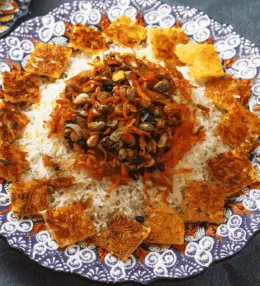
- View
Table of Contents
ToggleChupe de Camarones is one of Peru’s most comforting and deeply satisfying dishes. This rich shrimp chowder hails from Arequipa, a city nestled in the southern Andes, where bold flavours and hearty textures define the local cooking style.
It is the kind of dish you settle into. Warming, nourishing, and full of contrast, it brings together Andean potatoes, river shrimp, milk, eggs, and spice in one generous bowl. It is not light, but it is deeply balanced and soulful.
Whether eaten during a celebration or on a quiet Sunday with family, Chupe de Camarones is less about formality and more about comfort. It is food that holds history, tradition, and bold flavour in every spoonful.
Want to dive deeper into Peruvian Cuisine? Don’t miss our post on 25 Traditional Peruvian Foods to Try
What Is Chupe de Camarones?
Chupe de Camarones is a thick shrimp chowder that combines native Andean ingredients with European influences. It starts with a spicy, tomato based broth, thickened with potatoes and rice, then enriched with cream or milk and finished with fresh river shrimp.
Each bowl is generous and layered. You will find chunks of soft potato, kernels of corn, whole shrimp, and sometimes even a poached egg. It is filling enough to be a full meal and complex enough to stand out from lighter seafood soups.
The name “chupe” refers to a category of Peruvian stews and soups that are hearty and rustic. What sets this one apart is the use of camarones, or freshwater shrimp, and the unexpected richness of dairy and chilli blended in harmony.
Ingredients and Taste
Shrimp is the centrepiece of the dish, ideally river shrimp when available. The base is built with garlic, onion, tomato, and ají amarillo, a Peruvian chilli that adds warmth without overwhelming heat. Then come the potatoes and rice for body.
The flavour builds slowly. First the aromatics, then the richness of dairy, and finally the delicate sweetness of shrimp. It is creamy without being heavy, spicy without being overpowering, and layered in a way that invites you back for more.
Fresh herbs like huacatay or parsley may be added near the end for brightness. Some versions top the bowl with a poached or fried egg. The result is indulgent, but in a deeply comforting and generous way rather than overly rich or dense.
A Taste of History
Chupe de Camarones originates in Arequipa, where volcanic soil and mountain fed rivers support a rich culinary heritage. The dish likely began as a local adaptation, blending native produce with colonial Spanish techniques and ingredients.
Before dairy was introduced, the soup would have been simpler. With time, local cooks began enriching the broth with milk and cheese, reflecting the influence of European settlers. Yet the dish never lost its Andean heart.
River shrimp were once abundant in the streams near Arequipa. These became a staple for the region, celebrated in this chowder and served as a symbol of seasonal bounty. The use of local potatoes and maize reflects pre-Columbian farming traditions.
Today, Chupe de Camarones remains a signature dish of Arequipa and a proud example of regional Peruvian cooking. It captures what makes Peruvian cuisine so compelling, rooted in place, shaped by history, and always full of bold, generous flavour.
How to make Chupe de Camarones
Chupe de Camarones is a traditional Peruvian shrimp chowder rooted in the culinary traditions of Arequipa. Rich, creamy, and deeply flavourful, it combines native Andean ingredients with coastal seafood. Expect bold paprika warmth, tender shrimp, and creamy texture in every bite. See the recipe card at the bottom for printable directions
Ingredients
For the broth
- 1 kg whole freshwater shrimp or prawns (shell on)
- 1.5 litres water
- 2 tbsp olive oil
- 1 large onion, finely chopped
- 4 garlic cloves, minced
- 2 tbsp aji panca paste (or substitute with mild red chilli paste)
- 2 tsp ground paprika
- 1 tsp cumin
- Salt and black pepper, to taste
For the soup base
- 2 medium yellow potatoes, peeled and diced
- 1 large cob of corn, cut into 4 rounds
- 100g white rice
- 100g fresh peas
- 500 ml evaporated milk
- 200g queso fresco (or feta), cubed
- 2 large eggs
- 2 tbsp chopped fresh coriander
- 1 sprig fresh mint (optional)
Cooking Instructions
Step 1: Prepare the shrimp stock
To begin, separate shrimp heads and shells from the meat. Place shells and heads in a large pot with 1.5 litres of water. Simmer for 20 minutes, then strain and reserve the liquid. Move on to sautéing the base.
Step 2: Sauté the flavour base
In a large soup pot, heat olive oil over medium heat. Add onion and garlic, cooking until softened and golden. Stir in aji panca paste, paprika, cumin, salt, and pepper. Cook until the paste thickens and turns aromatic. Transition to combining with stock.
Step 3: Add the shrimp stock
Pour the strained shrimp stock into the sautéed spice mixture. Stir well to combine. Bring to a simmer and allow the flavours to meld for 5 minutes. Proceed to add starches and vegetables.
Step 4: Add rice, potatoes, and corn
Stir in rice, diced potatoes, and corn segments. Simmer for 15 minutes until the potatoes are tender and the rice is nearly cooked. Prepare to add peas and herbs.
Step 5: Add peas and herbs
Add the peas, fresh mint (if using), and half of the coriander. Simmer for another 5 minutes. Taste and adjust seasoning as needed. Prepare the milk mixture next.
Step 6: Add evaporated milk
Pour in the evaporated milk and stir gently. Bring the soup back to a low simmer without boiling. The milk enriches the broth and adds creaminess. Proceed to add shrimp and cheese.
Step 7: Add shrimp and cheese
Add the cleaned shrimp and cubed queso fresco. Simmer gently for 5 minutes or until shrimp are pink and cooked through. Avoid overcooking to keep shrimp tender. Move to the eggs.
Step 8: Poach the eggs
Crack each egg directly into the soup, spacing them apart. Cover the pot and simmer gently until the eggs are poached with set whites and soft yolks, around 3–4 minutes. Finish with final garnishes.
Final Step: Serve and garnish
Ladle the chowder into bowls, ensuring each portion includes a poached egg, shrimp, and cheese. Sprinkle with remaining coriander. Serve hot with crusty bread or toasted corn kernels for added crunch.
Variations and substitutions
- Replace queso fresco with firm ricotta or soft feta.
- Use prawn or langoustine if freshwater shrimp is unavailable.
- Aji amarillo can be added for a fruitier heat profile.
- Skip the poached eggs and stir in beaten eggs if preferred.
Cooking Tips for Perfect Chupe de Camarones
- Always use whole shrimp for maximum flavour in the stock.
- Don’t allow the milk to boil or it may curdle; keep it on a gentle simmer.
- Fresh peas and corn add essential texture and colour, avoid overcooking them.
- Crack eggs into the pot gently and poach undisturbed for a neater finish.
- If using feta, soak briefly in water to reduce saltiness before adding.

Peruvian Chupe de Camarones (Shrimp Chowder)
Ingredients
For the broth
- 1 kg whole freshwater shrimp or prawns shell on
- 1.5 litres water
- 2 tbsp olive oil
- 1 large onion finely chopped
- 4 garlic cloves minced
- 2 tbsp aji panca paste or substitute with mild red chilli paste
- 2 tsp ground paprika
- 1 tsp cumin
- Salt and black pepper to taste
For the soup base
- 2 medium yellow potatoes peeled and diced
- 1 large cob of corn cut into 4 rounds
- 100 g white rice
- 100 g fresh peas
- 500 ml evaporated milk
- 200 g queso fresco or feta, cubed
- 2 large eggs
- 2 tbsp chopped fresh coriander
- 1 sprig fresh mint optional
Instructions
- To begin, separate shrimp heads and shells from the meat. Place shells and heads in a large pot with 1.5 litres of water. Simmer for 20 minutes, then strain and reserve the liquid. Move on to sautéing the base.
- In a large soup pot, heat olive oil over medium heat. Add onion and garlic, cooking until softened and golden. Stir in aji panca paste, paprika, cumin, salt, and pepper. Cook until the paste thickens and turns aromatic. Transition to combining with stock.
- Pour the strained shrimp stock into the sautéed spice mixture. Stir well to combine. Bring to a simmer and allow the flavours to meld for 5 minutes. Proceed to add starches and vegetables.
- Stir in rice, diced potatoes, and corn segments. Simmer for 15 minutes until the potatoes are tender and the rice is nearly cooked. Prepare to add peas and herbs.
- Add the peas, fresh mint (if using), and half of the coriander. Simmer for another 5 minutes. Taste and adjust seasoning as needed. Prepare the milk mixture next.
- Pour in the evaporated milk and stir gently. Bring the soup back to a low simmer without boiling. The milk enriches the broth and adds creaminess. Proceed to add shrimp and cheese.
- Add the cleaned shrimp and cubed queso fresco. Simmer gently for 5 minutes or until shrimp are pink and cooked through. Avoid overcooking to keep shrimp tender. Move to the eggs.
- Crack each egg directly into the soup, spacing them apart. Cover the pot and simmer gently until the eggs are poached with set whites and soft yolks, around 3–4 minutes. Finish with final garnishes.
- Ladle the chowder into bowls, ensuring each portion includes a poached egg, shrimp, and cheese. Sprinkle with remaining coriander. Serve hot with crusty bread or toasted corn kernels for added crunch.
Nutrition
You May Also Like







Leave a Review